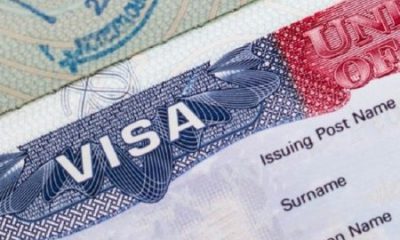Visa
US Visa: US Family Based Immigrant Visas, Types, How To Apply & More

Family immigrant visas allow relatives to join them in the US. The US government only allows close family members to reunite. Spouses, children, parents, and siblings are close relatives. Grandparents and cousins are not eligible.
Family members in the US must be lawful. Illegal immigrants cannot apply to bring their families to the US. These visas require LPR status, or a Green Card. US citizens can reunite with family through Immediate Relative (IR) Visas.
You can live in the US with family-based immigrant visas. Work while studying or attending university. Drivers licenses and property ownership are possible. Finally, short-term US travel is possible.
These permits are beneficial but limited. Each visa has a yearlong restriction and is processed first-come-first-served. Early application increases processing chances. After reaching the annual limit, applications are processed in the following years.
US immigrant visas have different categories based on the intent of immigration. These categories are:
- Family-Based Immigrant Visas to reunite with close family members;
- Employment-Based Immigrant Visas to work in the US without an Employment Authorization Document (EAD);
- Diversity Visas for those with low rates of immigration to the US;
- Returning Resident Visas for those who have once held a US immigrant visa and want to return to the country again.
What are the Types of Family Visas?
There are different types of family visas based on which family member is coming to the US. The visa types are:
- F-1 visas for unmarried sons and daughters of US citizens and their minor children;
- F-2 visas for spouses and children of Lawful Permanent Residents (LPR). They are of two categories:
- F-2A visas for spouses and minor children under 21 years old;
- F-2B visas for adult children over 21 years old;
- F-3 visas for married children of US citizens and their families (spouses and minor children);
- F-4 visas for siblings of US citizens and their families (spouses and minor children). To petition for siblings, the US citizen must be at least 21 years old.
Because of the numerical limits on these visas, they get a specific amount each year, such as:
- 23,400 people get the F-1 visa each year;
- 79,940 people get the F-2A visa each year;
- 34,260 people get the F-2B visa each year;
- 23,400 people get the F-3 visa each year;
- 65,000 people get the F-4 visa each year.
If there any leftover visas from one of the categories, the category after it gets them. For example, any unused F-1 visas go to F-2A visas and so on.
What are the Requirements for Family Immigration?
Each of these types of visas has their own requirements. The list below goes through them one by one.
For the F-1 visa, the requirements are:
- The US citizen must have birth or adoption certificates to prove relationship with sons/daughters
- The US citizen must have a valid US address;
- Sons/daughters must have birth or adoption certificates of their minor children to prove relationships. The children must be under 21 years old to qualify.
- The sons and daughters must be unmarried.
For the F-2A visa, the requirements are:
- The LPR must be at least 18 years old;
- The LPR must have a valid US address;
- The LPR’s children must be under 21 years old and unmarried;
- The LPR must have valid birth or adoption certificates to prove relationship with the children.
For the F-2B visa, the requirements are:
- The LPR must prove the relationship through a valid birth or adoption certificate;
- The LPR must have a valid US address;
- The adult child must be over 21 years old and unmarried.
For the F-3 visa, the requirements are:
- The US citizen must prove relationship through a valid birth or adoption certificate;
- The US citizen must have a valid US address;
- The US citizen’s child must be over 21 years old;
- The US citizen’s child must prove they are married through a valid marriage certificate;
- If the US citizen’s child also has minor children, they must prove relationship through a valid birth or adoption certificate.
For the F-4 visa, the requirements are:
- The US citizen must be at least 21 years old;
- The US citizen must have a valid US address;
- The US citizen must prove relationship with siblings through valid birth or adoption certificates;
- Siblings with minor children must prove relationship through valid birth or adoption certificates;
- Married siblings must prove relationship through valid marriage certificate.
All applicants must meet the requirements for their visa. If you do not fulfill them, the US Citizenship and Immigration Services (USCIS) could deny your visa.
How to Apply for US Family Visas?
The application process for family based immigrant visas is very similar. The process must start from the US citizen or LPR and then the person in the foreign country must apply. The steps for the application are as follows.
File the petition
The US citizen or LPR must petition USCIS for the family member. They need Form I-130, Petition for Alien Relative. USCIS approves or denies the petition. Approved cases go to the National Visa Center.
When the case is processed, the NVC provides the applicant a package. The package provides application instructions. For that application, the priority date became current. The applicant receives a case number and invoice ID from the NVC.
File Form DS-260
After the applicant gets the instructions, they have to apply for the visa. They must file Form DS-260, Online Immigrant Visa Application online and get the confirmation letter.
Complete medical exam and vaccination
The US requires certain medical exams and vaccines for those who want immigrant visas. The applicant must go to a licensed doctor or hospital to complete them and keep the records.
Compile supporting documents file
Other supporting documents must also be provided by the applicant. These documents will demonstrate that the applicant fits the visa requirements. Depending on the type of family visa, these documents may differ. Documents in the file include the following:
- A valid passport for more than 6 months after your intended departure to the US;
- A signed Form I-864, Affidavit of Support from the US petitioner or LPR;
- Form DS-260 confirmation page;
- Medical exam and vaccination documents;
- Two US Visa photographs that follow the Photo Requirements;
- Marriage certificates for those who are married;
- Birth or adoption certificates to prove relationships with children or siblings;
- Court and criminal records and/or police certificate;
- Those who were married before must bring divorce or death certificates to prove the marriage ended;
- If the applicant was in the military, they must bring military records.
Attend the interview
After processing, the US Embassy will invite the applicant for an interview. The questions will be on the background and the application. At the end, the officials will make a decision whether to give the visa or not.
Receive NVC packet and travel to the US
If the Embassy approves the visa, the NVC will send another package to the applicant. The applicant must not open this package. At the US port of entry, the border official will open the package and decide whether to let the person in the country or not.
What are the US Family Based Immigrant Visa Fees?
There are several fees to pay for family immigration visas. The petitioner and the applicant pay different fees. These fees are:
- Form I-130 filing fee – $535;
- Processing fee for the Form DS-260 – $230;
- Medical exam and vaccination fees;
- Fees to get and translate all supporting documents;
- USCIS Immigrant Fee – $220.
How Long is the Processing Time for Family Immigration Visas?
Considering family visas are limited in number, processing delays might be lengthy. The processing time is determined by when you apply. Applying early is preferable because you will receive significantly faster processing.
Family-based immigrant visa processing times might range from a few months to many years. Some visas can take up to 7 or 10 years to be processed in extreme situations. This is particularly typical in the case of F-2B, F-3, and F-4 visas. They have lengthy processing times because there are too many applicants.






















